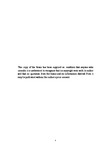Enhancing Civil Military Integration for Strategic Sealift
| dc.contributor.supervisor | Moustakis, Fotios | |
| dc.contributor.author | Pateras, George Dimitri | |
| dc.contributor.other | Faculty of Arts, Humanities and Business | en_US |
| dc.date.accessioned | 2017-09-04T09:16:57Z | |
| dc.date.available | 2017-09-04T09:16:57Z | |
| dc.date.issued | 2017 | |
| dc.identifier | 10369438 | en_US |
| dc.identifier.uri | http://hdl.handle.net/10026.1/9888 | |
| dc.description.abstract |
Our political and military leaders consider the efficient deployment and maintenance of personnel and hardware to be of equal importance to the task of planning the military operation. However, inasmuch as today’s military budgets are under great financial strain the military needs to rely on the civilian merchant navy for the provision of additional sealift capability. NATO acknowledges that member countries' ability to meet the politically desired levels of strategic sealift could be inadequate. Without a basic knowledge of the workings of the merchant navy, the military transportation desk officer cannot make an informed decision concerning the sealift capabilities required for strategic defence, humanitarian aid or refugee evacuation. This thesis reviews the range of militarily suitable commercial shipping and the different processes for chartering appropriate vessels while also considering the present state of civil/military synergies within NATO. It also examines the different types of insurance, including hull & machinery, third- party liability and commercial war-risks insurance and presents an overview of the problem of piracy. Its objective is to provide an introduction to the complex operational workings of the merchant navy for the military transportation officer. It is hoped that such knowledge could improve the sealift project not only in terms of operational effectiveness but also through increasing financial efficiency over a broad range of military and civil emergency maritime transportation services. Finally, two case studies are examined to demonstrate that there exists a plethora of solutions to the indicated challenges. A suggested handbook and flowchart are presented to assist in the implementation of this study's conclusions concerning the enhancement of acquired strategic sealift assets for defence, humanitarian aid or refugee evacuation. | en_US |
| dc.language.iso | en | |
| dc.publisher | University of Plymouth | |
| dc.subject.classification | PhD | en_US |
| dc.title | Enhancing Civil Military Integration for Strategic Sealift | en_US |
| dc.type | Thesis | |
| plymouth.version | publishable | en_US |
| dc.identifier.doi | http://dx.doi.org/10.24382/1071 | |
| dc.rights.embargoperiod | No embargo | en_US |
| dc.type.qualification | Doctorate | en_US |
| rioxxterms.version | NA |
Files in this item
This item appears in the following Collection(s)
-
01 Research Theses Main Collection
Research Theses Main


